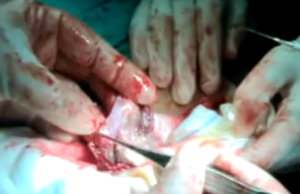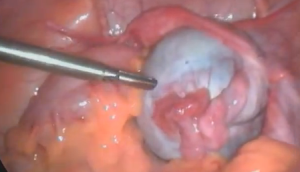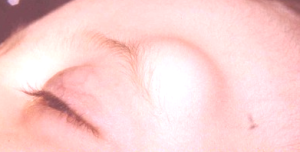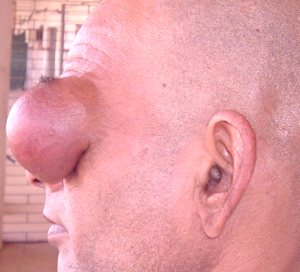What is a dermoid cyst ?
A dermoid cyst is a growth that has the appearance of sac like structures and is present from birth. There are several other structures that are present in a dermoid cyst such as fluids, hair, skin glands, teeth, etc. They can be found either in the skin or on its surface.
Dermoid cysts generally tend to grow at a slow pace. They do not elicit sensations of tenderness, unless they are ruptured. Some of common locations for dermoid cysts are the face, the lower back, inside the skull as well as the ovaries. Most cases of dermoid cysts on the face are shallow and can be eliminated without complications. However, one needs to consult specialists who have had intensive training, in order to remove rarer forms of dermoid cysts.
Symptoms of dermoid cyst
The rarer forms of dermoid cysts can be removed in the following ways:
- Dermoid cysts located in the nasal sinuses: Such cases of dermoid cysts are very rare. Every year, only a few cases involving dermoid cysts present in the nasal sinuses are reported. Doctors use special techniques to remove such dermoid cysts as the procedure is very complicated.
- Dermoid cysts located in the brain: It is another rare form of the condition. In case, such dermoid cysts affect the effective functioning of an affected individual, then a neurosurgeon must be consulted for their removal.
- Dermoid cysts located in the spinal cord: Such dermoid cysts are also rare. They are connected to the surface of the skin via a sinus tract. The sinus tract is a slim connection from a deep hole within the skin. Dermoid cysts of the spinal cord are at greater risk to infection. It is often difficult to completely remove such cysts, but the prognosis generally tends to be good.
- Dermoid cysts located in the ovaries: Such dermoid cysts generally tend to form in a woman during her fertile years. They can result in complications such as cancer, infection, torsion and rupture. The ovarian dermoid cysts can be removed by traditional surgical methods. The doctor may also employ laparoscopy, which is a surgical method that uses tiny incisions and unique medical equipments to enter the pelvis or the abdomen.
When to seek the attention of a health care provider
Affected individuals may contact a doctor in case of the following occasions:
- There is change in color or size of the dermoid cyst
- There is inflammation or pain due to the dermoid cyst
- If the dermoid cyst has caused disfigurement and removal is required for cosmetic purposes.
Cases of dermoid cysts generally do not require any emergency medical attention. However, if such cysts become inflamed, rupture or if they result in fever or pain, then affected individuals may seek immediate medical opinion. The amount of discomfort or pain that results from dermoid cysts, may also determine the need for emergency hospitalization and care.
Causes of dermoid cyst
- At the time of fetal formation, when the skin and other skin parts become trapped, then it results in the formation of dermoid cysts.
- The cell walls of dermoid cysts are almost identical to the cell walls of the outer surface of skin.
- Additionally, dermoid cysts may consist of several other structures such as sweat glands, hair follicles and on occasions, nerves, teeth or hair.
Diagnosis of dermoid cyst
- All individuals should be aware of the difference between dermoid cysts and other facial growths, before opting for their removal.
- Dermoid cysts are present from birth and tend to grow very slowly. Hence, their detection is often during childhood or adolescence
- They are not connected to the skin present above
- Dermoid cysts are solid and do not cause any pain, unless they burst
- On rare occasions, a dermoid cyst may go beyond the skin and penetrate deeper into other tissues such as an oral cavity. Such cases are usually diagnosed with a CT scan and other types of imaging studies. However, such tests are conducted only if a health care provider suspects that there is a case for the presence of a deep-level dermoid cyst. He/she may also weigh the risks involved as against the benefits to be gained.
Dermoid cyst removal
- It is important to note that one should not indulge in self-care methods for the removal of dermoid cysts at home. Self- care methods usually result in incomplete removal of the dermoid cyst, which increase the chances of its re-growth. Additionally, most of us are usually unable to differentiate between skin growths that are harmless and those which can result in medical complications. Removal of dermoid cysts is therefore not recommended as the risk to bleeding, infection and other complications are greater with self care treatment methods.
- In order to treat harmless cases of dermoid cysts, a doctor will completely clean the dermoid cysts and the adjacent areas, administer local anesthesia and then make a cut directly above the cyst. This will result in effective and complete removal of the cyst.
- Rare cases of dermoid cysts need to be treated by specialists as discussed above.
- Surgical removal of dermoid cyst is usually smooth and does not result in any undue complications. Such operations generally lead to a full recovery of the patient.
Dermoid cyst pictures
Here are pictures of dermoid cyst including surgery pictures




Wow, marvelous blog layout! How long have you been blogging for? you make blogging look easy. The overall look of your web site is excellent, let alone the content!
fantastic points altogether, you simply received a logo new reader. What would you suggest about your post that you just made some days in the past? Any certain?